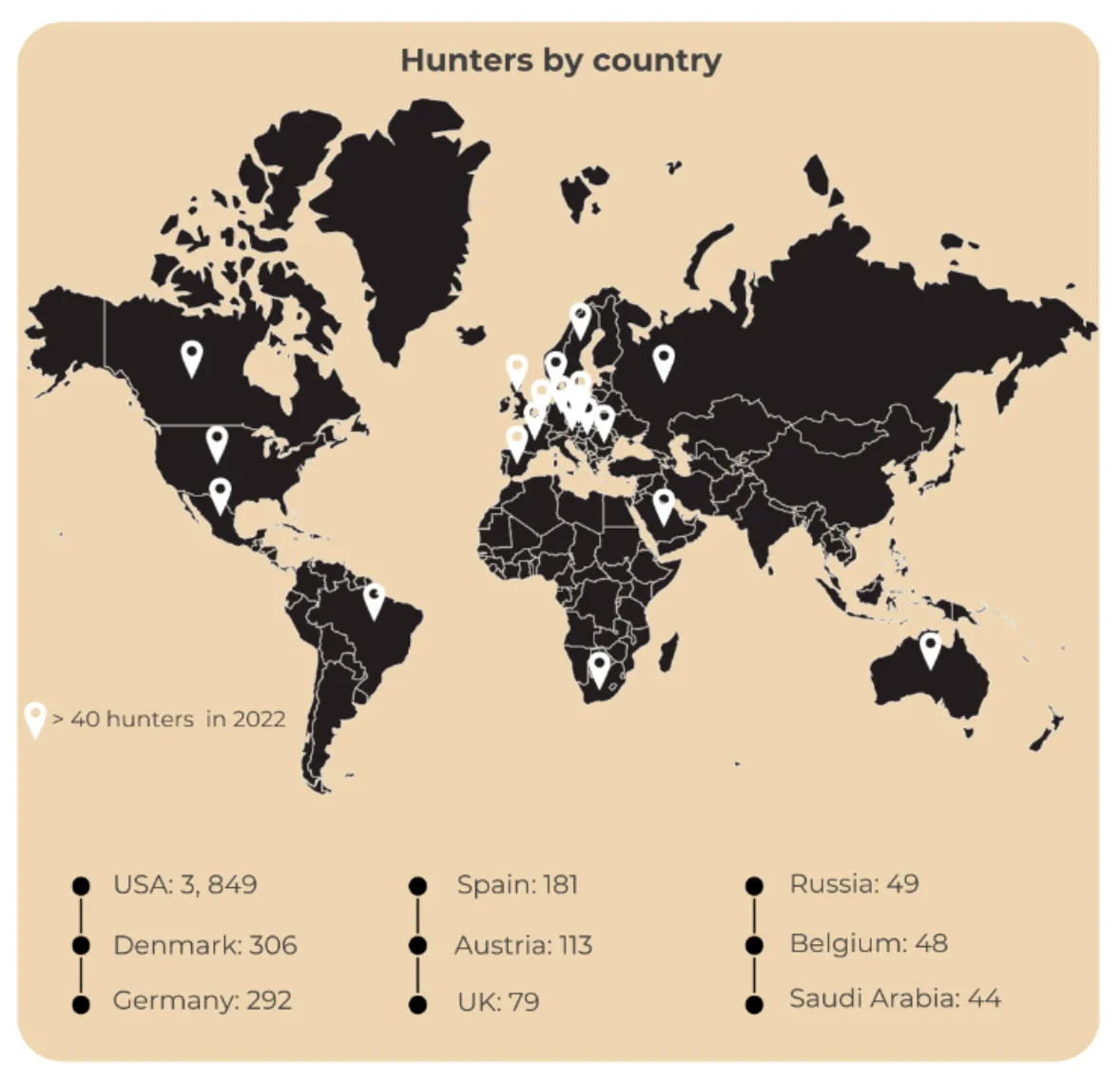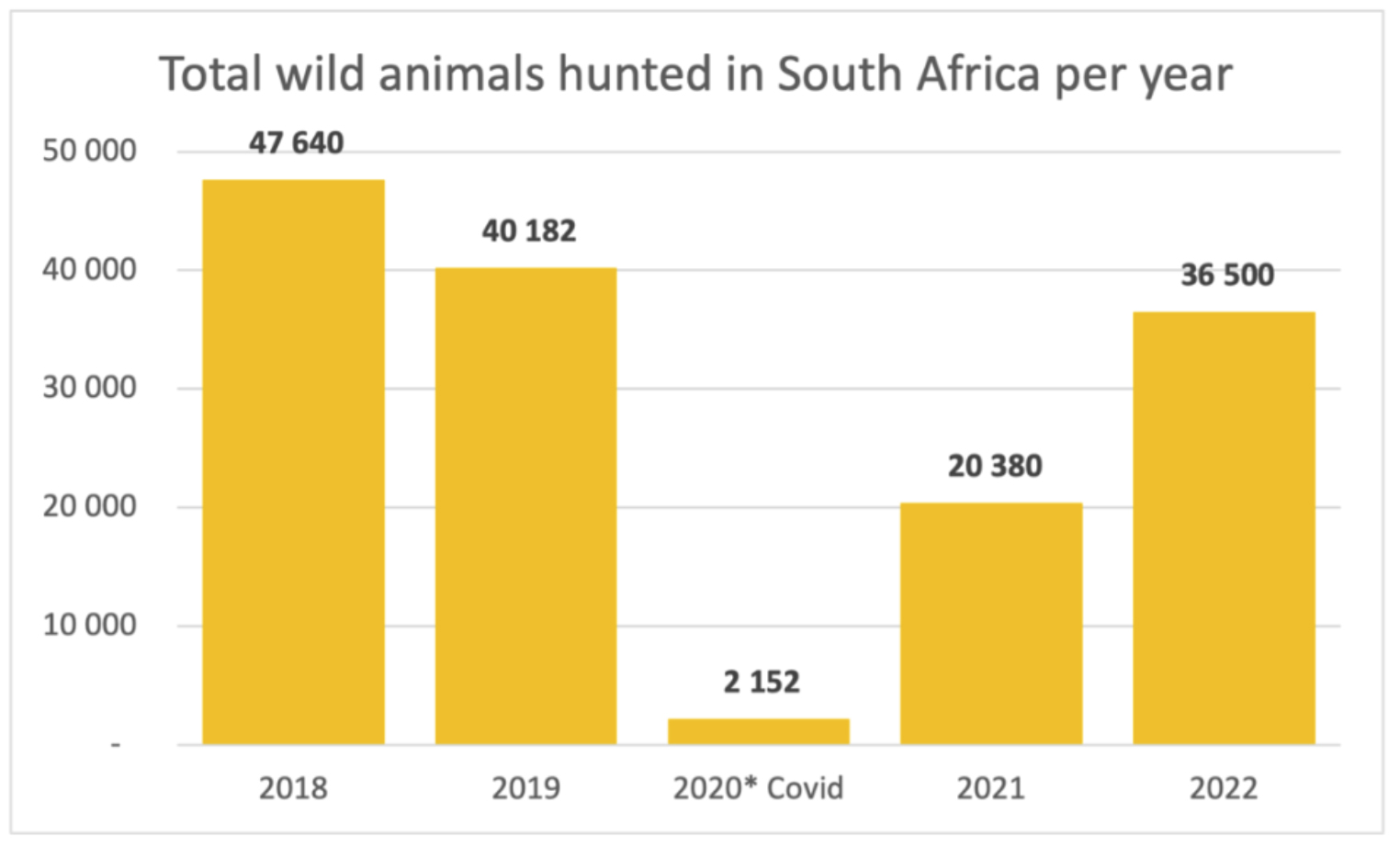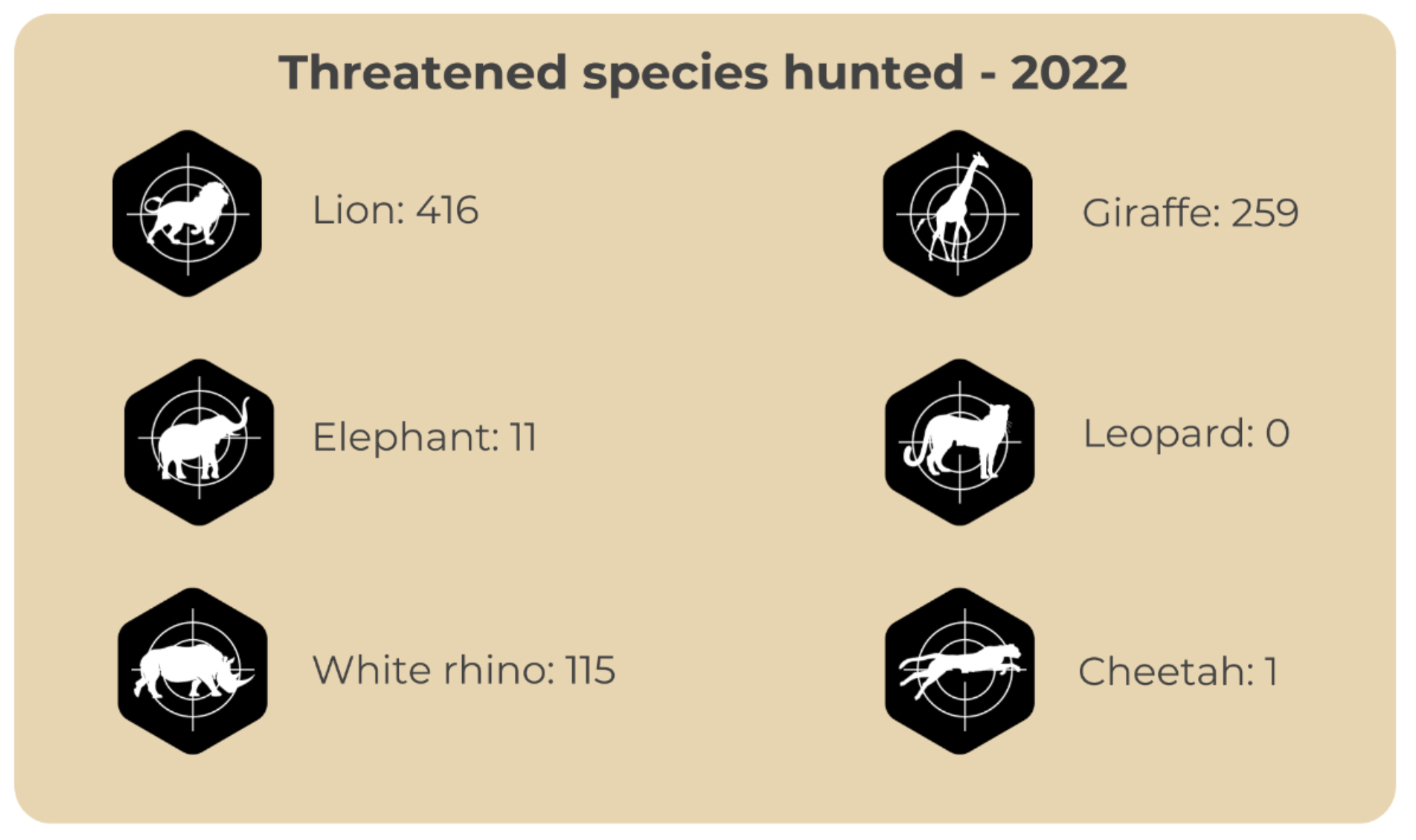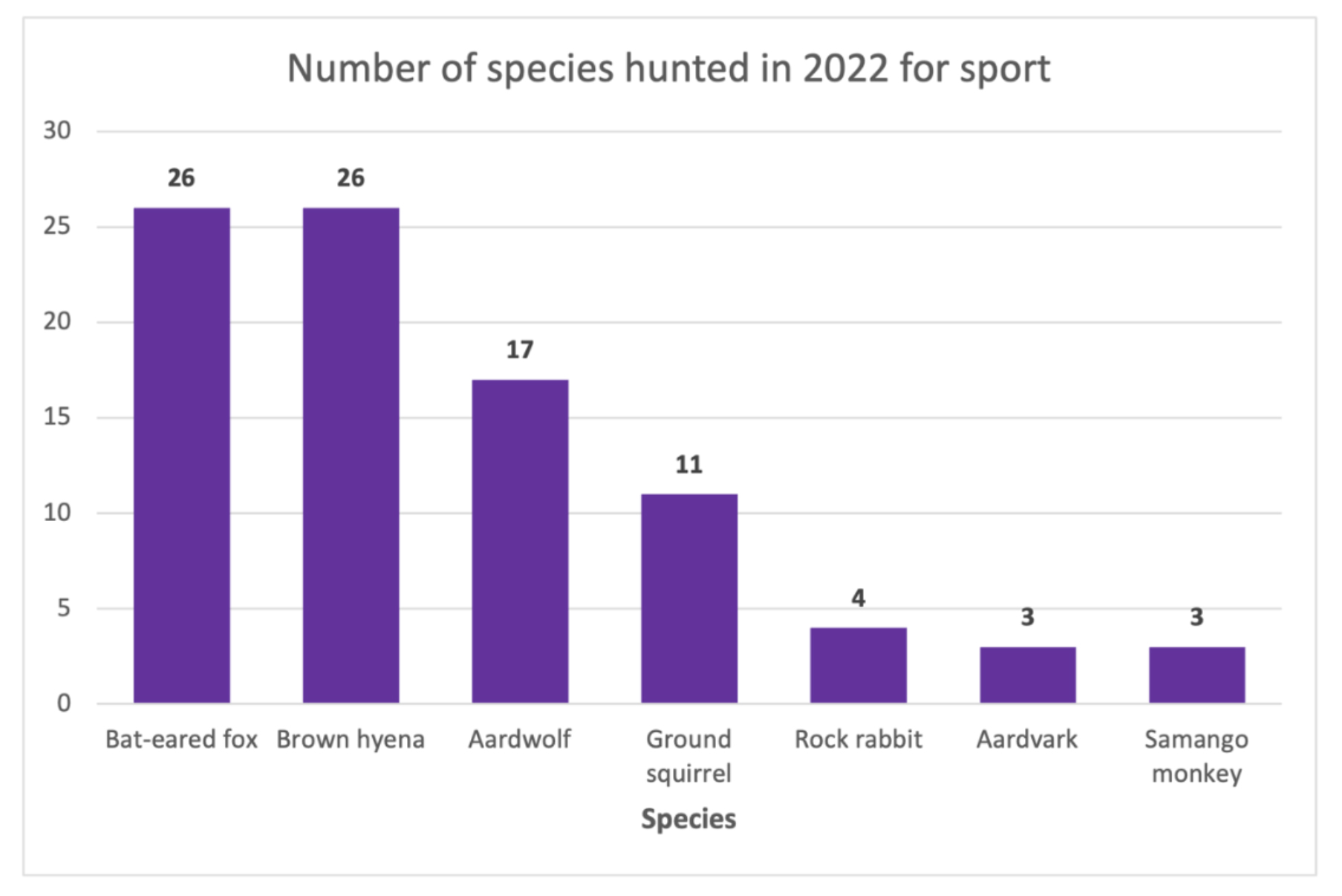It was eventually forced to do so using a Protection of Information Act (Paia) request. This lack of transparency raises a number of questions.
Is Minister Barbara Creecy trying to shield the industry from the worldwide abhorrence against trophy hunting and its colonial legacy which threatens Brand South Africa? Or is it to protect an industry that shows no signs of transformation and offers little local community benefit? Could it be to conceal the demographic of international trophy hunters entering South Africa?
Trophy hunting must be one of the least “transformed” industries in the country. In answer to a parliamentary question in 2022 by Minister Creecy, only 101 (4%) of 2,786 registered professional hunters may be categorised as previously disadvantaged individuals.
According to professional hunting statistics, most hunters are predominantly wealthy westerners.
For those who facilitate the hunting of South Africa’s wild animals, however, it’s a very lucrative industry. Despite worldwide disfavour, wealthy international trophy hunters still flock to South Africa to kill from the iconic to the unknown, indigenous to exotic, and often endangered animals. Of 6,242 international hunters 3,849 (62%) were American, with smaller numbers from European nations, including Denmark, Spain, and Germany.

The professional hunting statistics from 2022 paint a disturbing picture of the number and variety of animals shot by international trophy hunters (only) during 2022 with a total of 36,500 animals shot by 6,242 clients.

The animals hunted did not include only typical Big Five, but included several small and rarely seen creatures that stand no chance against rifles and bows. These include servals, suricates, genets and mongoose. Nearly 200 bat-eared and Cape foxes were also hunted. Four black-footed cats fetched a mere $100 each — an animal so rarely seen that many wildlife lovers and photographers would pay dearly to see one, if for just a moment, in the wild.


Despite increasing concern for our threatened and vulnerable species, 115 white rhinos (listed as a near-threatened species) were hunted, compared to 56 in 2021, for an average price tag of $31,500 each, a slap in the face of the anti-poaching teams who risk their lives to keep rhinos alive for a lot less money. The hunting of 115 rhinos for trophies is all the more disturbing given that 451 rhinos were poached in 2021 and 448 in 2022.
Notwithstanding universal condemnation of South Africa’s captive lion industry and official policy to shut this down, 395 lions were killed in 2021 and 416 in 2022, with a decreased price tag of $15,000 to $11,625 each. Research conducted by Blood Lions and World Animal Protection demonstrates that 1,572 captive-bred lions were hunted between 2017 and 2020 with the North West conservation authorities issuing the majority of permits at 1,544 (90,5%).
Trophy hunting remains a contentious issue among conservationists, animal welfare groups and the hunting lobby, but it required renewed scrutiny with the recent acceptance of the White Paper on Conservation and Sustainable Use of South Africa’s Biodiversity. This aspirational new vision includes “an inclusive, transformed society living in harmony with nature, where biodiversity conservation and sustainable use ensure healthy ecosystems, with improved benefits that are fairly and equitably shared for present and future generations”.
Until now, South Africa’s history of conservation has been based on archaic, colonial thinking that secured protected land through forced removals and exclusion and a “fences and fines” approach that vilified the poacher while celebrating the hunter, an approach that is still prevalent. So the White Paper is notable in seeking a new take on conservation from a legislative and historical perspective and begs two questions: does trophy hunting have a place in a progressive, equitable and harmonious vision of protecting biodiversity; and is the notion of trophy hunting as sustainable use and protection of biodiversity a cover story for its excessive consumption?
 UK trophy hunting import ban – some animals are more equal than others
UK trophy hunting import ban – some animals are more equal than others
Job creation is frequently cited as an important benefit of trophy hunting in rural communities, yet closer investigation by environmental economist Ross Harvey demonstrates that such jobs are seasonal compared to year-round tourism and he points to possible damages to ecotourism caused by the trophy hunting of animals sought by tourists.
Another question, given that biodiversity is under increasing threat: are hunting revenues being re-invested into its protection and genuinely sustainable use?
It is claimed by hunters that they protect wildlife and contribute to local communities. Aside from the troubling notion that wealthy Western hunters are the only true guardians of the environment and poor communities, do these claims hold up?
In 2022 Minister Creecy responded to a parliamentary question on income generated from trophy hunting in 2019. She said R208-million (out of a total of R1.1-billion for all types of hunting) was derived from the trophy hunting of threatened or endangered species.
However, her department was unable to provide a breakdown of where the money went as there’s no legal requirement for hunting outfitters to report these figures. Following a Paia request regarding community benefits, the department added that “these records do not exist” and “there is no legal requirement compelling the department to keep the details of expected community benefit and revenue”.
Dr Mucha Mkono of the University of Queensland Business School in Brisbane, Australia, who conducted a study in 2019 on African social media users’ attitudes towards trophy hunting, found a strong sense of resentment towards privileged Western tourists having more access to wildlife than local citizens. Notably, trophy hunting was considered a neo-colonial form of tourism.
According to Mkono, “the very underdeveloped status of many of the rural areas where hunting occurs tells us what we need to know. The benefits are not trickling down enough to make a real difference in the local communities. Whatever benefits there are, their scope fails to justify the ethical and environmental cost”.
University of Cape Town researcher Dr Femke Brandt found in 2015 that no significant change has occurred in the redistribution of wealth between land owners and farm workers in the transition of land from farming to wildlife. Their employment remains based on minimum wage earning and the individual discretion of each land owner. There is added danger of living and working on a wildlife farm with little to no protection and employee benefits.
The upshot is that arguments used to justify the economic and social benefits of trophy hunting in South Africa remain weak and a lack of transparency still favours a colonial sport for the privileged few.















